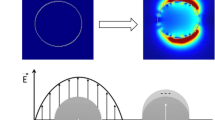Abstract
Ag nanoparticles (AgNPs) solutions were prepared and grown by photochemical reaction using white light sources, specifically such as a Xe lamp, the sunlight, and an incandescent lamp. Dichroism, also called the “Lycurgus effect”, was observed in the obtained AgNPs solutions that were irradiated with white light for several days. The color of the transmitted light through the AgNPs solutions that were irradiated with the Xe lamp, the sunlight, and the incandescent lamp were orange, red, and blue, respectively, whereas the color of scattered light was greenish in all the samples. Based on the results of the transmittance, reflectance spectra, and scanning electron microscope images, the dichroic phenomenon is mainly caused by localized surface plasmon resonance light scattering of large triangular prismatic and decahedral AgNPs. In addition, we successfully prepared a dried silica gel that contains AgNPs with a dichroic property similar to the Lycurgus cup. This was fabricated by the solidification of the AgNPs solutions that were prepared under sunlight irradiation by a sol–gel method.








Similar content being viewed by others
References
Kreibig U, Vollmer M (1995) Optical properties of metal clusters. Springer, New York
Dahmen C, von Plessen G (2007) Optical effects of metallic nanoparticles. Austral J Chem 60:447–456
Weyl WA (1951) Coloured glasses. Society of Glass Technology, Sheffield
Freestone I, Meeks N, Sax M, Higgitt C (2007) The Lycurgus cup—a roman nanotechnology. Gold Bull 40:270–277
Barber DJ, Freestone IC (1990) An investigation of the origin of the colour of the lycurgus cup by analytical transmission electron microscopy. Archaeometry 32:33–45
le Masne de Chermont Q, Chanéac C, Seguin J et al (2007) Nanoprobes with near-infrared persistent luminescence for in vivo imaging. PANS 104:9266–9271
von Kerssenbrock-Krosigk D (2008) Glass of the Alchemists: lead crystal-gold ruby. Corning Museum of Glass, New York, pp 1650–1750
Neri A (1612) L’ arte vetraria. Florence
Schlager N, Lauer J (2000) Science and its times: understanding the social significance of scientific discovery. Gale Group, Farmington Hills
Callegari A, Tonti D, Chergui M (2003) Photochemically grown silver nanoparticles with wavelength-controlled size and shape. Nano Lett 3:1565–1568
Pietrobon B, Kitaev V (2008) Photochemical synthesis of monodisperse size-controlled silver decahedral nanoparticles and their remarkable optical properties. Chem Mater 20:5186–5190
Stamplecoskie KG, Scaiano JC (2010) Light emitting diode irradiation can control the morphology and optical properties of silver nanoparticles. JACS 132:1825–1827
Gartia MR, Hsiao A, Pokhriyal A et al (2013) Colorimetric plasmon resonance imaging using nano lycurgus cup arrays. Adv Opt Mater 1:68–76
Yang L-C, Lai Y-S, Tsai C-M, Kong Y-T, Lee C-I, Huang C-L (2012) One-pot synthesis of monodispersed silver nanodecahedra with optimal SERS activities using seedless photo-assisted citrate reduction method. J Phys Chem C 116:24292–24300
Wang H, Zheng X, Chen J et al (2012) Transformation from silver nanoprisms to nanodecahedra in a temperature-controlled photomediated synthesis. J Phys Chem C 116:24268–24273
Tang B, Xu S, Hou X et al (2013) Shape evolution of silver nanoplates through heating and photoinduction. ACS Appl Mater Interfaces 5:646–653
Author information
Authors and Affiliations
Corresponding author
Rights and permissions
About this article
Cite this article
Ueda, J., Samusawa, M., Kumagai, K. et al. Recreating the Lycurgus effect from silver nanoparticles in solutions and in silica gel. J Mater Sci 49, 3299–3304 (2014). https://doi.org/10.1007/s10853-014-8047-0
Received:
Accepted:
Published:
Issue Date:
DOI: https://doi.org/10.1007/s10853-014-8047-0




